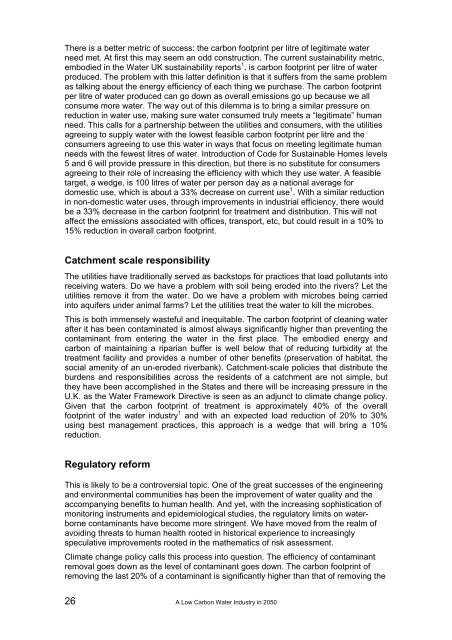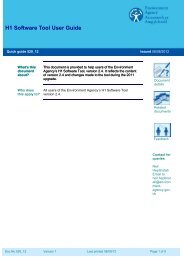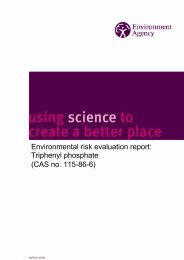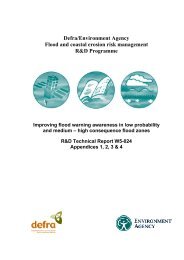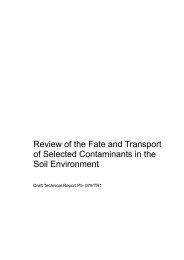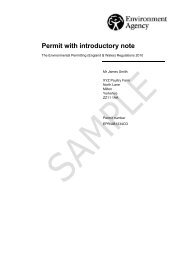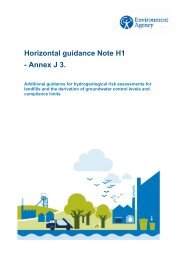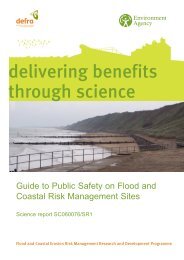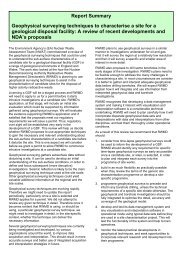A Low Carbon Water Industry in 2050 - Environment Agency
A Low Carbon Water Industry in 2050 - Environment Agency
A Low Carbon Water Industry in 2050 - Environment Agency
Create successful ePaper yourself
Turn your PDF publications into a flip-book with our unique Google optimized e-Paper software.
There is a better metric of success: the carbon footpr<strong>in</strong>t per litre of legitimate water<br />
need met. At first this may seem an odd construction. The current susta<strong>in</strong>ability metric,<br />
embodied <strong>in</strong> the <strong>Water</strong> UK susta<strong>in</strong>ability reports 1 , is carbon footpr<strong>in</strong>t per litre of water<br />
produced. The problem with this latter def<strong>in</strong>ition is that it suffers from the same problem<br />
as talk<strong>in</strong>g about the energy efficiency of each th<strong>in</strong>g we purchase. The carbon footpr<strong>in</strong>t<br />
per litre of water produced can go down as overall emissions go up because we all<br />
consume more water. The way out of this dilemma is to br<strong>in</strong>g a similar pressure on<br />
reduction <strong>in</strong> water use, mak<strong>in</strong>g sure water consumed truly meets a “legitimate” human<br />
need. This calls for a partnership between the utilities and consumers, with the utilities<br />
agree<strong>in</strong>g to supply water with the lowest feasible carbon footpr<strong>in</strong>t per litre and the<br />
consumers agree<strong>in</strong>g to use this water <strong>in</strong> ways that focus on meet<strong>in</strong>g legitimate human<br />
needs with the fewest litres of water. Introduction of Code for Susta<strong>in</strong>able Homes levels<br />
5 and 6 will provide pressure <strong>in</strong> this direction, but there is no substitute for consumers<br />
agree<strong>in</strong>g to their role of <strong>in</strong>creas<strong>in</strong>g the efficiency with which they use water. A feasible<br />
target, a wedge, is 100 litres of water per person day as a national average for<br />
domestic use, which is about a 33% decrease on current use 1 . With a similar reduction<br />
<strong>in</strong> non-domestic water uses, through improvements <strong>in</strong> <strong>in</strong>dustrial efficiency, there would<br />
be a 33% decrease <strong>in</strong> the carbon footpr<strong>in</strong>t for treatment and distribution. This will not<br />
affect the emissions associated with offices, transport, etc, but could result <strong>in</strong> a 10% to<br />
15% reduction <strong>in</strong> overall carbon footpr<strong>in</strong>t.<br />
Catchment scale responsibility<br />
The utilities have traditionally served as backstops for practices that load pollutants <strong>in</strong>to<br />
receiv<strong>in</strong>g waters. Do we have a problem with soil be<strong>in</strong>g eroded <strong>in</strong>to the rivers Let the<br />
utilities remove it from the water. Do we have a problem with microbes be<strong>in</strong>g carried<br />
<strong>in</strong>to aquifers under animal farms Let the utilities treat the water to kill the microbes.<br />
This is both immensely wasteful and <strong>in</strong>equitable. The carbon footpr<strong>in</strong>t of clean<strong>in</strong>g water<br />
after it has been contam<strong>in</strong>ated is almost always significantly higher than prevent<strong>in</strong>g the<br />
contam<strong>in</strong>ant from enter<strong>in</strong>g the water <strong>in</strong> the first place. The embodied energy and<br />
carbon of ma<strong>in</strong>ta<strong>in</strong><strong>in</strong>g a riparian buffer is well below that of reduc<strong>in</strong>g turbidity at the<br />
treatment facility and provides a number of other benefits (preservation of habitat, the<br />
social amenity of an un-eroded riverbank). Catchment-scale policies that distribute the<br />
burdens and responsibilities across the residents of a catchment are not simple, but<br />
they have been accomplished <strong>in</strong> the States and there will be <strong>in</strong>creas<strong>in</strong>g pressure <strong>in</strong> the<br />
U.K. as the <strong>Water</strong> Framework Directive is seen as an adjunct to climate change policy.<br />
Given that the carbon footpr<strong>in</strong>t of treatment is approximately 40% of the overall<br />
footpr<strong>in</strong>t of the water <strong>in</strong>dustry 1 and with an expected load reduction of 20% to 30%<br />
us<strong>in</strong>g best management practices, this approach is a wedge that will br<strong>in</strong>g a 10%<br />
reduction.<br />
Regulatory reform<br />
This is likely to be a controversial topic. One of the great successes of the eng<strong>in</strong>eer<strong>in</strong>g<br />
and environmental communities has been the improvement of water quality and the<br />
accompany<strong>in</strong>g benefits to human health. And yet, with the <strong>in</strong>creas<strong>in</strong>g sophistication of<br />
monitor<strong>in</strong>g <strong>in</strong>struments and epidemiological studies, the regulatory limits on waterborne<br />
contam<strong>in</strong>ants have become more str<strong>in</strong>gent. We have moved from the realm of<br />
avoid<strong>in</strong>g threats to human health rooted <strong>in</strong> historical experience to <strong>in</strong>creas<strong>in</strong>gly<br />
speculative improvements rooted <strong>in</strong> the mathematics of risk assessment.<br />
Climate change policy calls this process <strong>in</strong>to question. The efficiency of contam<strong>in</strong>ant<br />
removal goes down as the level of contam<strong>in</strong>ant goes down. The carbon footpr<strong>in</strong>t of<br />
remov<strong>in</strong>g the last 20% of a contam<strong>in</strong>ant is significantly higher than that of remov<strong>in</strong>g the<br />
26 A <strong>Low</strong> <strong>Carbon</strong> <strong>Water</strong> <strong>Industry</strong> <strong>in</strong> <strong>2050</strong>


